In spring 1981 I signed a license agreement with Coronet Boats of Slagelse Denmark. Coronet would manufacture the blades, and I would create new designs.
Coronet was a well renowned boat building company, manufacturing sailing yachts as well as motorboats. Some of the designs by world famous yacht-sailor Paul Elvström. Coronet had declining turnover in the boat business, and was ready to try a new challenge for their skilled staff, that had worked with fibreglass for many years.
Coronets predecessor firm was Botved Boats founded in 1951 by Ole Botved.
From 1981 the blades were known as AeroStar blades. Coronet was later reconstructed and renamed to Alternegy. Later the name of the company became Danish Commercial Energy Research A/S or just DCER.
|
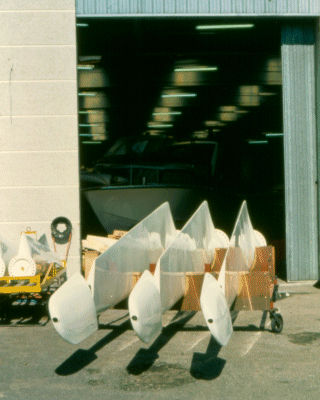 |
| Blades fly in - Boats sail away 1981 - 82 |
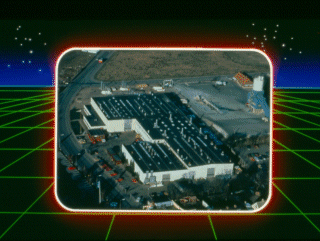 |
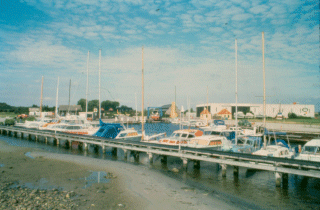 |
| Aerial view of the Slagelse facility (in 1984) |
Coronet also had a facility at the harbour of Mullerup |
Coronet workers were trained by Økær Vind Energi employees in summer 1981. In addition to moulds transferred from Økær, new and higher quality moulds were made in 1981 for 4 of the 5 different Økær designs.
3.5 m, 5 m, 6m and 7.5 m (The 2.5 m was not produced at Coronet) |
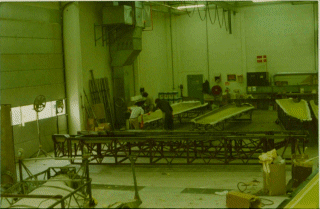 |
| Part of moulding shop in 1981 |
| |
|
| "November-Hurricane" and Root fatigue failure - Hinnerup #2 |
November 24th - 25th 1981 - a Hurricane hit Denmark, causing vast destruction all over the country.
Also a Vestas turbine with AeroStar 7.5 m blade failed.
Again at Hinnerup near Aarhus. |
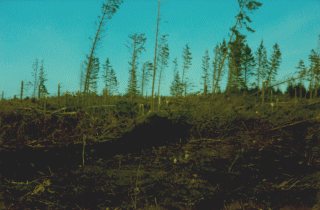 |
| "The November Hurricane" 1981 Denmark |
| On my way to visit the failed Hinnerup turbine, I passed this failed Windmatic turbine at Viborg. |
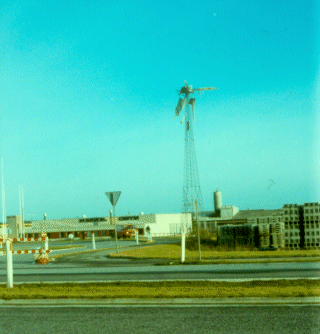 |
| Harvest of the November hurricane |
Hinnerup 2 failure :
Root fatigue in Økær blade at Vestas V15- 55 kW
The Økær and Aerostar blades used a blade root system developed by German professor Ulrich Hütter. Glas roving threads running from the root cylinder - around bushings for the root bolts - and back to the blade root cylinder.
The system was very sensitive to correct mounting and maintenance of the bolt tensioning.
Despite the sensibility of the Hütter root system, still today, after more than 25 years of service - many old Økær and Aerostar blades with Hütter roots are still producing electricity around the world. |
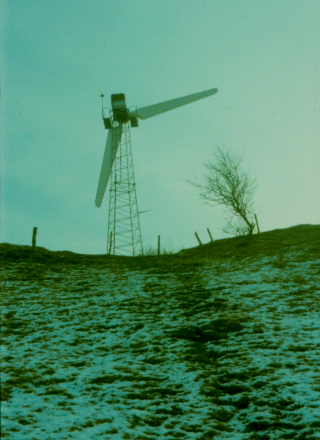 |
| The Hinnerup turbine, at the edge of a gorge. |
After the blade-failure of this Vestas turbine - Vestas decided to start up development of their own blade-design.
The first Vestas blade was a 7.5 m blade with a SG-cast steel root part. The weight of the steel part was 230 kg.
Despite Vestas own blade development, Vestas still purchased Aerostar 7.5 meter blades in 1985. (Which most people do not know). |
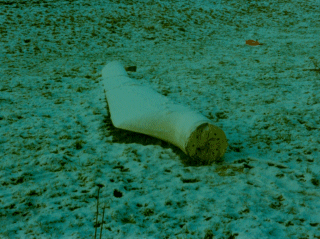 |
| The failed blade |
As a consequence of the root fatigue failure in the hurricane of November 1981 in Denmark - a new root system was developed. The Hütter system was to be abandoned, and the blade root was glued into a cast steel cylinder. This root proved very well in the static test of May 18th 1982.
Persons seen in the picture are - seen from left: Kaj Holte (craftsman of Alternegy), Peter Hjuler Jensen, RISØ Test Station - Mr. Petersen of Alternegy, Hans Lilholt of RISØ Materials Research, Erik Grove-Nielsen, Flemming Rasmussen of RISØ Test Station, and unknown person.
|
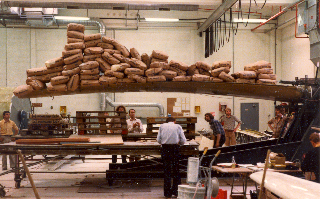 |
| Steel Root in Static Test - controlled by RISØ |
However this new steel-root design led to a 15 % increase in blade price - Only 5 sets were sold. (Bonus and KL van der Linden). A cheaper - enhanced version of the usual Hütter type root was chosen by most customers.
In 1985 we made the first blade with inserted steel studs - at the AeroStar 12 meter blade.
Today a similar system is used by a. o. LM Glasfiber and Vestas. |
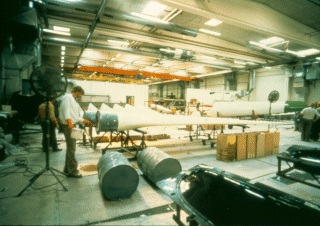 |
| AeroStar Steel Root in production for Bonus - 1982 |
California Wind Rush 1982 - 1986
|
Visionary American politicians opened a great marked for the worlds Wind Industry. Also the Danes grabbed that opportunity.
In 1982/1983 the first Danish wind turbines were shipped to California. Until 1986 this Californian Wind Rush kept Danish companies busy, especially the last weeks of the year, as turbines should be commissioned, and on line before December 31st, in order to secure the investors their federal-, and state- tax credits. |
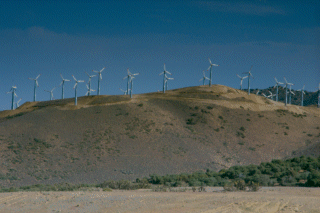 |
| Oak Creek - Tehachapi |
|
|
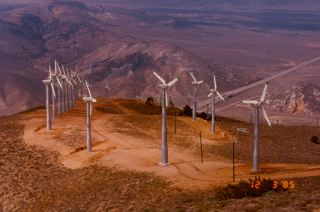 |
| Bonus 55 kW at Arbutus site - Tehachapi Ca. USA |
| |
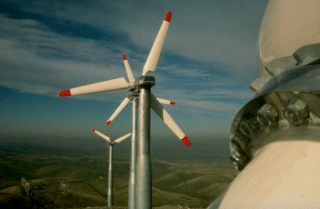 |
| Nordtank 55 KW at Altamont , Cal. USA |
| |
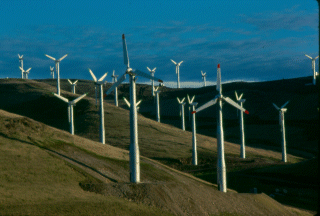 |
| The terrain could create high turbulence intensity |
| |
 |
| Micon 55 kW at Altamont , Cal. USA |
| Production at Slagelse |
Beside the production in Slagelse, 4 subcontractors produced AeroStar blades in Denmark:
EM Fiberglas, Sønderborg Yachtværft, Rimas, Kværkeby Glasfiber. |
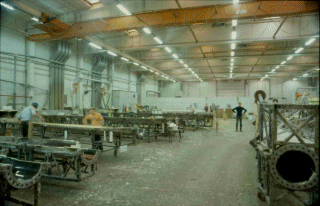 |
| Moulding area ca. 1985 |
To ensure correct curing of the thin laminates near the blade tip hot air was circulated to the tip area.
In years 1985 to 86 a stringent quality control system was implemented. |
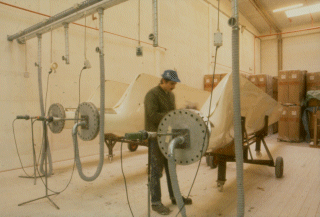 |
| Post cure of blades |
In 1985 a 9 meter blade was developed for 100 kW turbines..
In 1986 a 12 meter blade was developed for 150 kW turbines. |
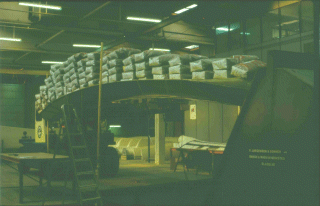 |
| Static test of 9 m blade 1985 |
| |
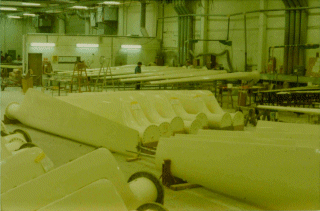 |
| AeroStar 9 m blades in finishing shop 1985 |
| |
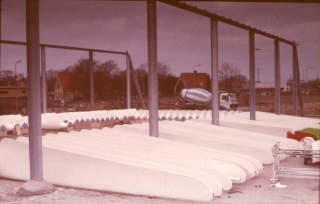 |
| 7.5 m and 9 m Blades for the world - at Slagelse |
| |
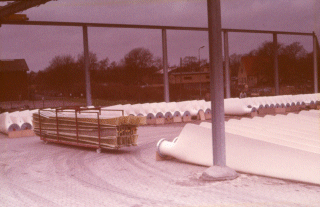 |
| 9 m blades - and a wagon holding I-beams |
|
|
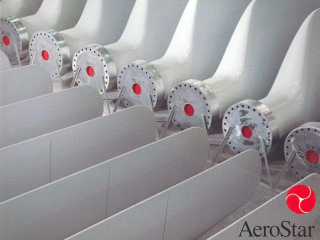 |
| AeroStar 9 meter blades in finishing shop |
AeroStar Fleet at show -
3.5 m :: Super 5 m :: 6 m :: 7.5 m :: 9 m :: 12 m
As can be seen - the root system of the 12 m is different, this is the first Danish fibreglass blade using inserted steel studs, with internal threads. (Later - LM and Vestas also began using inserted steel studs.)
(Earlier AeroStar blades all had Hütter type root.) |
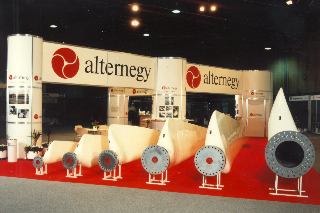 |
| AeroStar Fleet 1986 |
| Fatigue Blade Testing at Sparkær - AeroForm (and at RISØ) |
| In 1984 Erik Grove-Nielsen established a four-blade fatigue test facility at Sparkær. |
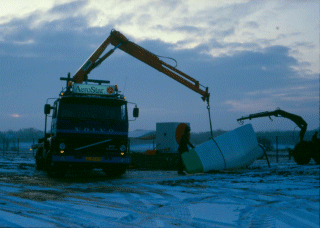 |
| Blade arrives at fatigue test Sparkær 1984 |
In the black boxes the exciters are located. An electric motor rotates an eccentric mass near the eigenfrequency of the blade. At a low energy consumption the fatigue test can run for months.
Data acquisition equipment was placed in a nearby container. I had a cable to my private home 1 mile away. A microphone and amplifier in the central hub allowed me to listen to the sound of the fatigue test in our sleeping room! |
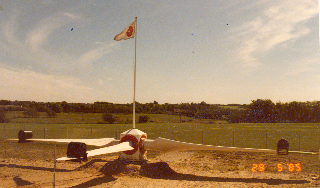 |
| Fatigue test rig for 4 blades of max. 20 m |
| |
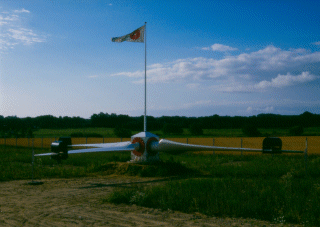 |
| |
|
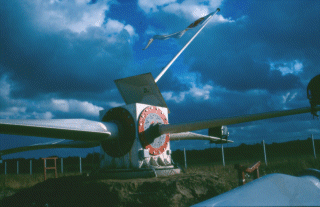 |
| Blades interior could be inspected with video camera |
In 1984 RISØ performed some fatigue testing of an AeroStar 7.5 meter blade. The system was based on an iron core oscillating through the magnetic field of a solenoid (coil).
|
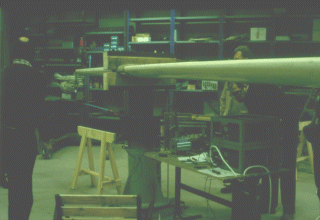 |
| Aerostar 7.5 m at Fatigue test at RISØ |
AeroStar blades was delivered to 26 countries around the world - from arctic climates to hot desert areas.
For blades used in Palm Spring area California, Vestas wanted a static test performed at 60 °C (140 °Fahrenheit). The test was performed at RISØ inside a heated tent on July 11th 1984.
Peter Hjuler of RISØ takes a measure, while Svend Brink of Vestas watches. (Blade is barely seen behind Svend Brink) |
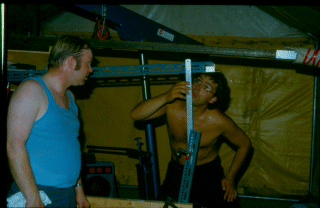 |
| Aerostar blade at "Desert temperature test" at RISØ |
To satisfy the important US customers DCER (Aerostar) established 2 production sites in the USA:
In Lodi, California, in a former ultra light plane factory.
and
|
 |
| Aerostar production at Lodi |
| In new buildings in Crookston, Minnesota. |
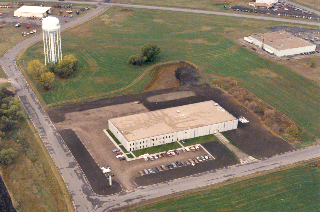 |
| AeroStar new build facility at Crookston |
| Nordtank 55 kW turbines were placed on a new pier at the Ebeltoft car ferry harbour, near Nordtanks domicile at Balle. |
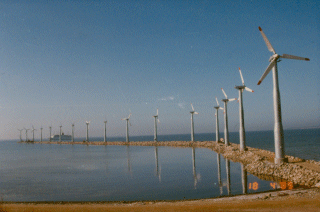 |
| On shore farm at Ebeltoft Denmark erected 1984 |
| In Holland the company Kaal van der Linden developed a turbine having two rotors, placed at a tulip-market garden near Amsterdam |
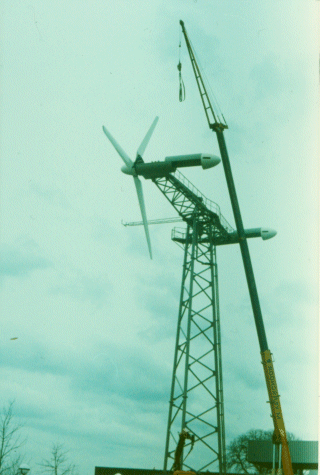 |
| Twin master at Hillegom, Holland ( 7.5 m Aerostar) |
At RISØ, near Copenhagen turbines were tested, but facilities for blade testing was inappropriate, only one test rig for maximum 11 meter blades existed.
As I saw the need for extensive testing of blades in static and fatigue tests, I decided to enlarge my private fatigue test-station at Sparkær with a complete test facility with static test hall, material laboratory etc.
|
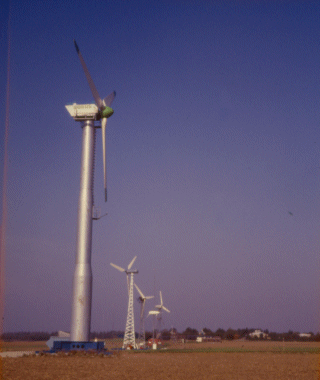 |
| Turbine row at RISØ Test Station 1985 |
1985 - 86 Erik Grove-Nielsen builds a 0.8 mio.US$ blade test facility for AeroForm at Sparkær.
In 1986 we had testing facilities for simultaneous fatigue testing of 4 blades of maximum length 20 meter. The new static test hall allowed a maximum blade length of 20 meter.
|
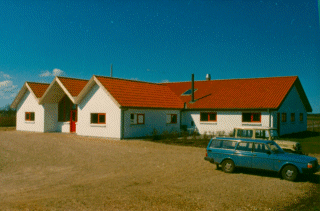 |
| The AeroForm Center - inaugurated August 1986 |
| |
|
| |
|
| |
|

